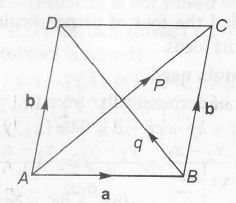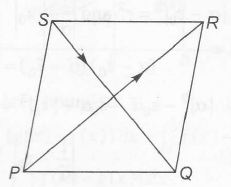Answer:
Option C
Explanation:
Concept involved . it involves law of parallelogram and volume of parallelopiped . i.e,
a+b=p and b-a =q
$a=\frac{p-q}{2}$
and $b=\frac{p+q}{2}$

i.e, if p and q are diagonals of parallelograms , then its sides are $\frac{p-q}{2}$ and $\frac{p+q}{2}$
Situation analysis
After finding the sides of parallelogram we should find volume of parallelopiped i.e, [a,b]

HERE, sides of parallelogram are PQ and PS
where, $PQ=\frac{PR+SQ}{2}$
=$PQ=\frac{(3\hat{i}+\hat{j}-2\hat{k})+(\hat{i}-3\hat{j}-4\hat{k})}{2}$
$PQ=2\hat{i}-\hat{j}-3\hat{k}$
and PS=$\frac{PR-SQ}{2}$
= $PS=\frac{(3\hat{i}+\hat{j}-2\hat{k})-(\hat{i}-3\hat{j}-4\hat{k})}{2}$
PS =$\hat{i}+2\hat{j}+\hat{k}$
$\therefore$ Volume of parallelopiped
=[PT PQ PS]
= $\begin{bmatrix}1 & 2 &3\\2 & -1&-3\\1&2&1 \end{bmatrix}$
=1(-1+6)-2(2+3)+3(4+1)
=5-10+15=10